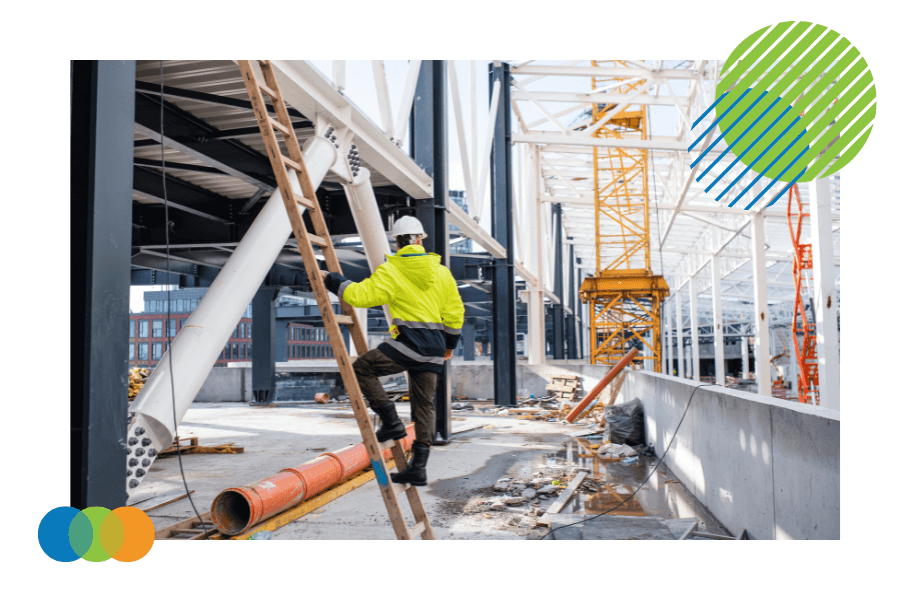 |
Written by Liz McDermott |

Ladders are a standard tool used in various industries, from construction to maintenance, but they can also be one of the most dangerous. According to the Occupational Safety and Health Administration (OSHA), falls from ladders account for many yearly injuries and fatalities. Scaling new heights can be daunting, but with the proper training and safety measures, it can be done safely and effectively.
This article will discuss some valuable tips for effective safety training practices that will help minimize the risks and ensure a safe working environment. Whether you're a seasoned professional or a new employee, these tips will provide you with the knowledge and skills to handle ladders confidently and safely.
What is a Ladder Safety Training Course?
Ladder safety training is a course designed to educate workers on properly using ladders in the workplace. The course typically covers the basics, such as equipment selection, inspection, setup, and use. The training also includes information on fall protection and prevention and teaches the proper techniques for climbing and descending ladders. Workers who complete this training receive a certificate of completion to meet regulatory compliance.
Employers are responsible for providing a safe working environment for their employees, and proper safety training is essential to achieving that goal. Employees who receive ladder safety training will be better equipped to handle ladders safely and effectively, reducing the risk of injury or death.
The training can be conducted in-house or by a third-party training provider. In-house training allows employers to tailor the course with hands-on demonstrations. A third-party vendor like Vubiz offers a standardized ladder safety training that meets regulatory requirements with the flexibility to customize the course to the company's specific needs and work environment and includes a final exam before testing the learner's knowledge before receiving a certificate of completion.
Free Ladder Safety Training
OSHA offers a basic safety training course in a PowerPoint presentation format that you can download for free and a Portable Ladder Quick Safety Card on its website. These free ladder safety training resources are available to all U.S. employers and workers.
What are ladder safety training requirements?
Employers must provide safety training to all employees who use ladders on the job. The safety training course must cover the following core topics:
- Nature of fall hazards in the work area
- Correct procedures for erecting, maintaining, and disassembling the fall protection systems to be used
- Proper construction, use, placement, and care in handling all stairways and ladders
- Maximum intended load-carrying capacities of ladders used
- Standards related to the particular types of ladders used
Employers must also ensure that a competent person trains all employees who use access ladders. A competent person is defined as someone capable of identifying hazards and taking prompt corrective action to eliminate them.
Types of Ladders and Their Uses
Many types of ladders are available, each designed for a specific purpose. The most common types of ladders used in the workplace include:
- Extension ladders: Extension ladders are used for tasks that require the worker to reach high places. They consist of two or more sections that can be extended or retracted to adjust the ladder's height.
- Step ladders: Step ladders are self-supporting ladders designed for use on level surfaces. They are commonly used for tasks such as painting or changing light bulbs.
- Rolling ladders: Rolling ladders are designed to be moved from one location to another. They are commonly used in warehouses and stockrooms.
- Platform ladders: Platform ladders are similar to step ladders but have a larger platform at the top, providing a stable work surface.
Each type of ladder has its own unique set of safety considerations. Choosing the right one for the job is essential, ensuring it is appropriately used.

How to Pick the Right Ladder for the Job
Proper ladder selection is essential to ensuring safety in the workplace. Before choosing a ladder, consider the following factors:
- Height: Ensure it's tall enough to reach the work area without standing on the top rung. This is important because standing on the top rung can cause the ladder to become unstable and increase the risk of falling.
- Weight capacity: Ensure it supports the worker's weight and any equipment or materials they carry.
- Type of Work: Consider the work performed on the ladder. For example, a built-in tool tray may be appropriate if the worker uses power tools.
- Environment: Consider the environment in which the ladder will be used. For example, if the ladder is used near electrical wires, a fiberglass ladder may be more appropriate than an aluminum ladder.
Inspecting the ladder before each use is essential to ensure it is in good condition and safe. Never use a ladder that is damaged or broken.
Common Ladder Hazards and Mistakes
Ladder-related accidents are common in construction worksites but can occur wherever ladders are used. Some of the most common incidents include:
- Falling from ladders: Falling from ladders can be caused by various factors, including improper setup, overreaching, and standing on the top rung of the ladder.
- Tip-overs: Ladders can tip over if not set up correctly or used on uneven ground.
- Electrocution: Workers can be electrocuted if they come into contact with electrical wires using a metal ladder.
- Muscle strains and sprains: Overexertion while climbing or carrying heavy loads on a ladder can lead to muscle strains and sprains.
Following proper safety procedures and using the appropriate safety equipment to prevent accidents is essential.

How to Safely Set Up Your Portable Ladder
Setting up a portable ladder can be hazardous if not done correctly. To do it in a safe matter, follow these steps:
- Choose a flat, stable surface: The surface on which the ladder is placed should be flat, stable, and free of any debris or obstacles.
- Check the ladder: Inspect the equipment before use to ensure it is in good condition. Check for any cracks, dents, or other damage.
- Angle correctly: The ladder should be placed at a 75-degree angle to the ground. This can be achieved by placing the base of the equipment one foot away from the wall for every four feet of its height.
- Secure the ladder: Use stabilizers or tie-downs to secure it in place and prevent it from tipping over.
- Climbing: Always face the equipment when climbing up or down. Use three points of contact (two hands and one foot or two feet and one hand) when climbing.
Fall Prevention Training
Fall prevention training is an essential component of employee training and education. Fall prevention techniques include:
- Using a safety harness: Workers working at heights should use a harness to prevent falling.
- Installing guardrails: Guardrails can be installed on elevated surfaces to prevent falling.
- Using a safety net: Safety nets can be installed below elevated work areas to catch workers in the event of a fall.
- Proper setup: Proper setup is essential to preventing falls from ladders.
By following proper fall prevention techniques, workers can minimize the risk of falls and injuries in the workplace.
Safety Accessories
Safety accessories can be used to enhance ladder safety and prevent accidents. Some common accessories include:
- Stabilizers: used to increase the stability of a ladder and prevent it from tipping over
- Levelers: used on uneven surfaces to ensure a ladder is level and stable
- Mitts: used to protect the surface from scratches and other damage
- Stoppers: used to prevent the ladder from sliding down the wall
Using safety tools and accessories can help prevent ladder-related injuries in the workplace.
Ladder Safety Systems
Ladder safety systems are designed to provide additional fall protection for workers who use ladders. Some common ladder safety systems include:
- Vertical lifelines: Vertical lifelines are attached to the ladder and provide continuous fall protection while climbing up or down.
- Horizontal lifelines: Horizontal lifelines are used with a harness to provide fall protection while working on elevated surfaces.
- Fall arrest systems: Fall arrest systems are designed to stop a fall in progress and prevent the worker from hitting the ground.
Safety systems can provide access to an additional layer of protection for workers who use ladders in the workplace.
In Summary: Implementing Ladder Safety Training Can Save Lives
Ladder safety training is essential for ensuring a safe working environment for employees using ladders. Workers can minimize the risk of ladder-related injuries by following proper safety procedures and using the appropriate safety equipment.
Employers are responsible for providing safety training and ensuring employees use ladders safely and effectively. By implementing safety training and safe work practices, employers can reduce the risk of a citation should an incident occur.
It's important for employers and employees to take the risk of ladder falls seriously and prioritize safety in the workplace. We can create and maintain a safer working environment for everyone by working together.
For more information, please contact us to inquire about our Health & Safety training.


